Your faucet is the center of attraction in your bathroom space. Choosing the right faucet will complement the overall design and aesthetic. If you’re not sure where to start, it can be a challenging task. Fear not! We’re going to break down all the details that go into picking the right faucet for your bathroom sink.
As I had to choose one myself on numerous occasions, I researched what goes into picking the right faucet for your bathroom sink. I put down my findings in this blog post so you can benefit from them.
After reading this, you’ll know how to choose the right faucet for your bathroom sink. We’ll cover the different types of faucets, such as single-handle and double-handle, wall-mounted and deck-mounted, and touchless and manual. We’ll also discuss the materials and finishes, such as chrome and brushed nickel. So, let’s dive in.
Types of Faucets
Let’s review the various types of faucets to become familiar with them. Being informed about the different types will assist you in selecting the best faucet for your bathroom sink.
Compression Faucets
Compression faucets are among the oldest and most traditional types of faucets commonly found in homes. They operate on a simple mechanism where a rubber washer or seal is compressed against the valve seat to control the flow of water. When the faucet handle is turned, it lowers the stem and compresses the washer against the valve seat, thereby stopping the flow of water.
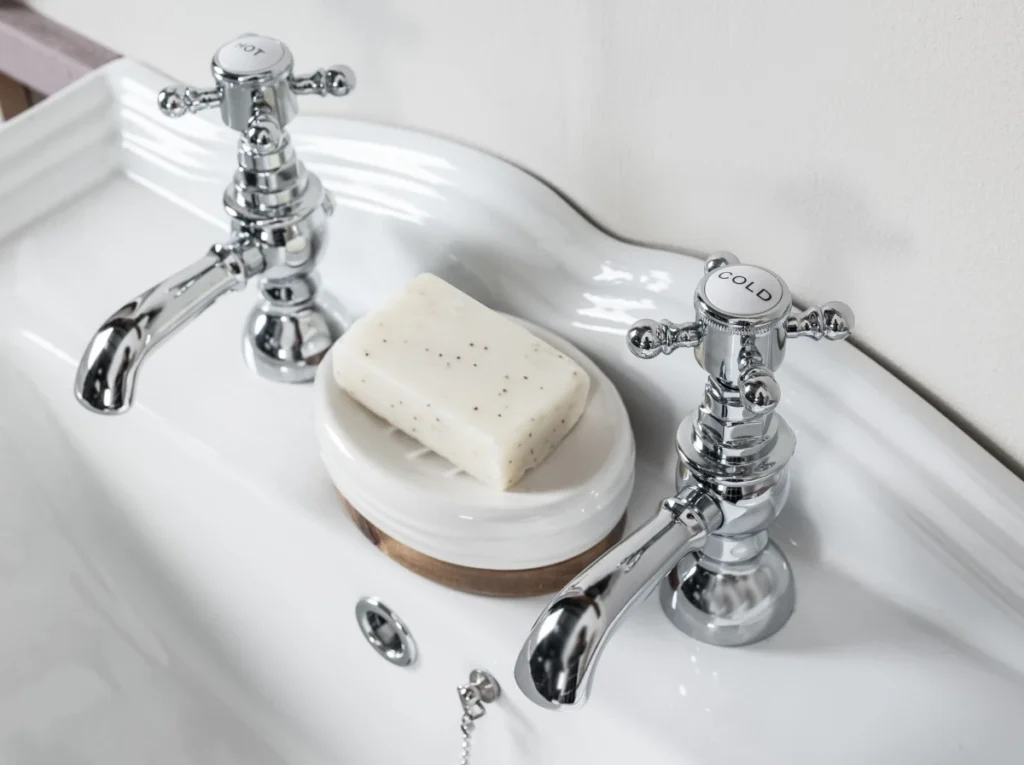
Cartridge Faucets
Cartridge faucets represent a modern evolution in faucet design, offering improved functionality and ease of use compared to traditional compression faucets. Instead of relying on rubber washers to control the flow of water, cartridge faucets use a cartridge mechanism to regulate both water flow and temperature.
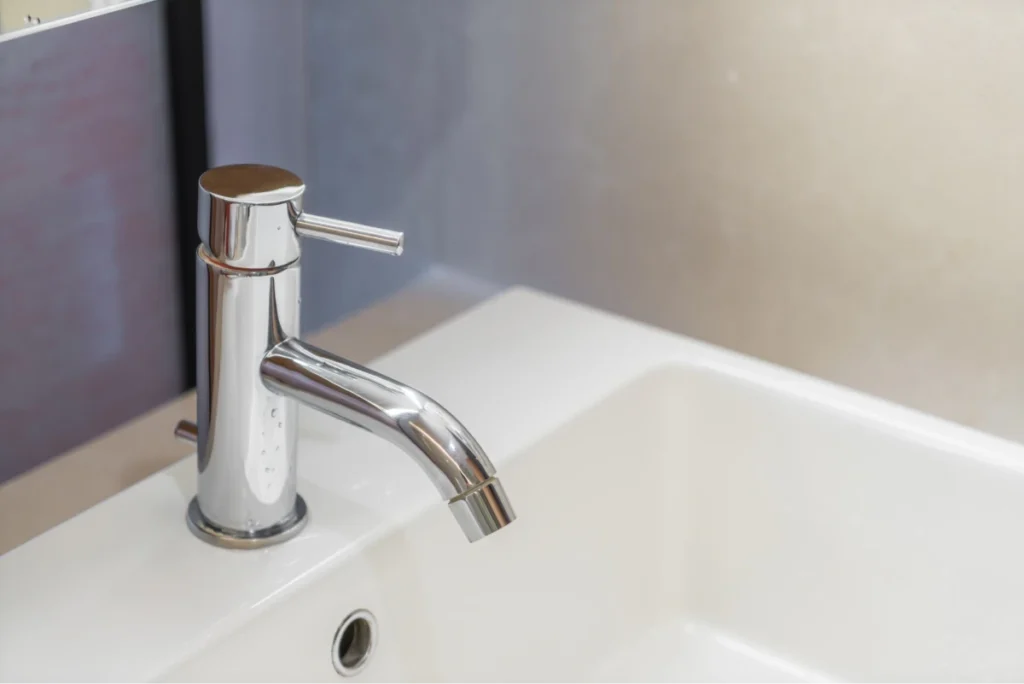
Ball Faucets
Ball faucets, also known as ball-valve faucets, are recognizable by their single handle that controls both the temperature and flow of water. These faucets feature a ball-shaped cap, hence the name, which houses the internal mechanism responsible for regulating water flow and temperature.
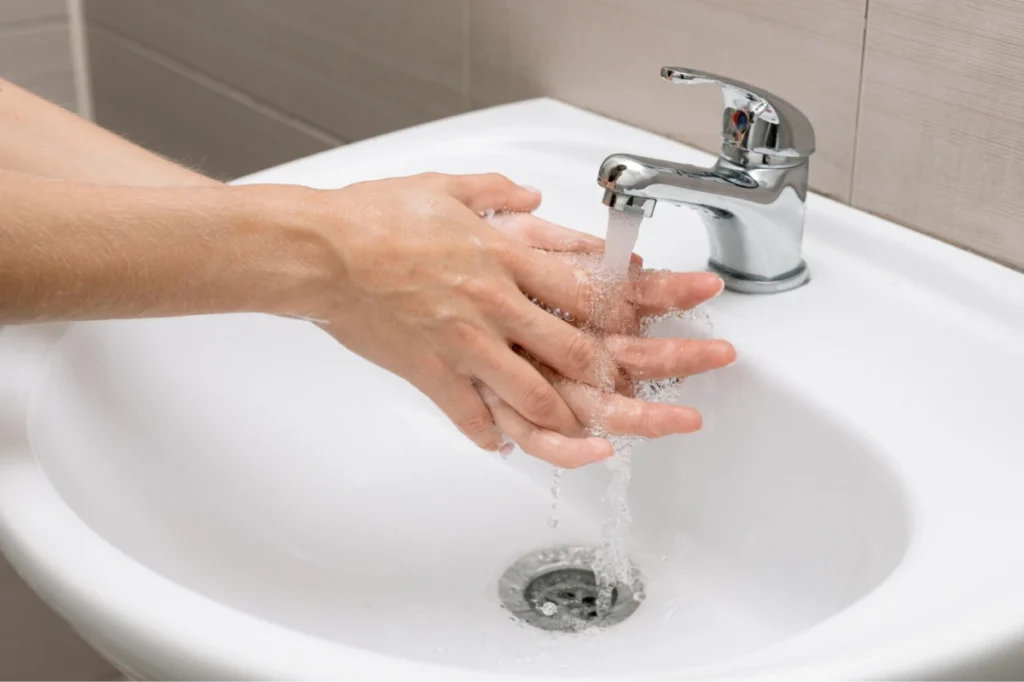
Ceramic Disc Faucets
Ceramic disc faucets represent a modern and efficient solution for controlling water flow and temperature in bathrooms. Unlike traditional compression faucets that use rubber washers, ceramic disc faucets feature ceramic discs or cartridges that rotate to regulate the flow of water. This design offers several advantages in terms of durability, reliability, and ease of use.
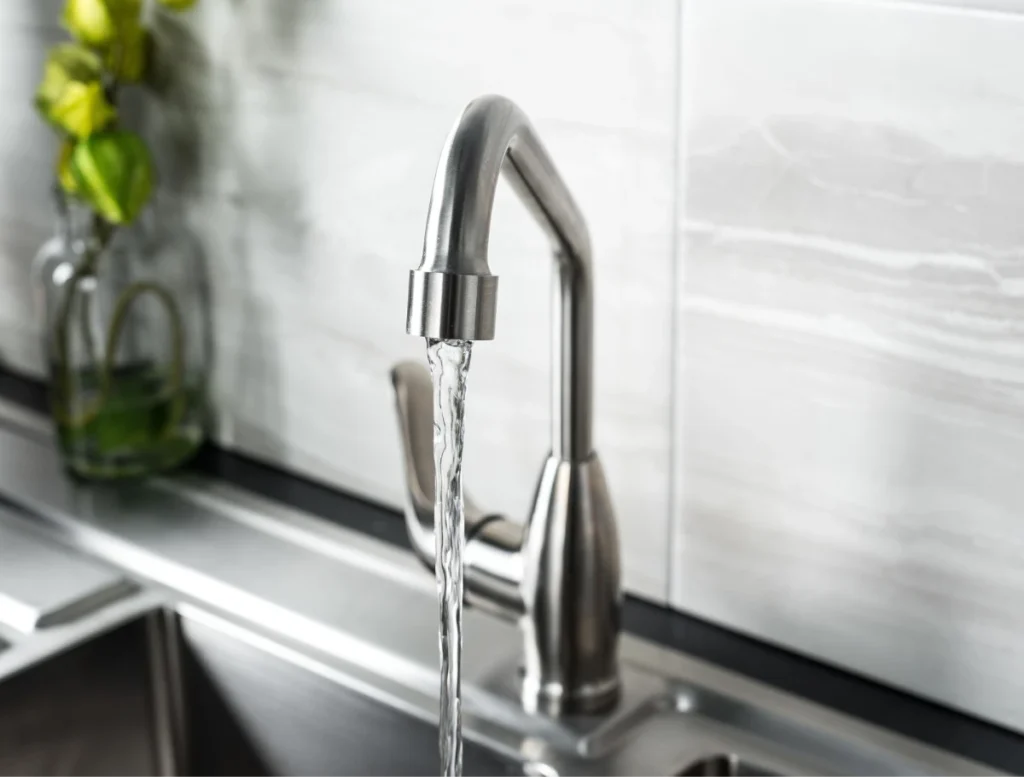
Wall Mount Faucets
Wall mount faucets offer a stylish and space-saving solution for bathroom sinks, where the faucet is mounted directly onto the wall rather than on the countertop or sink itself. This distinctive installation method not only adds a unique visual appeal to the bathroom but also frees up valuable countertop space, making it an ideal choice for smaller bathrooms or contemporary design aesthetics.
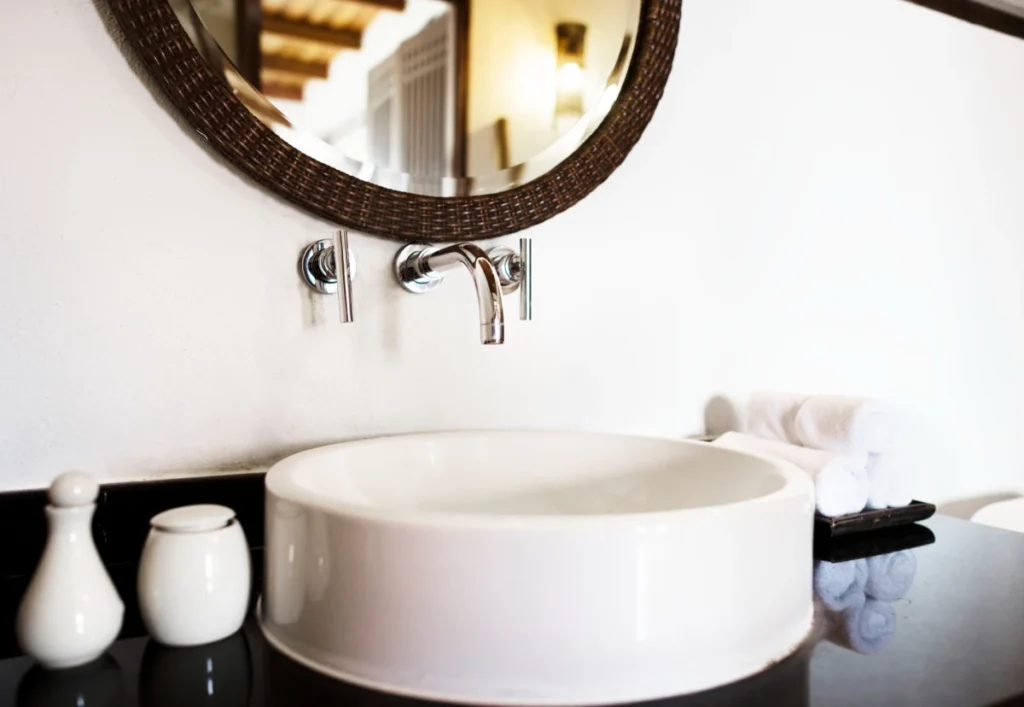
Single-Hole Faucets
Single-hole faucets, as the name suggests, are designed to fit into a single mounting hole on the bathroom sink or countertop. These faucets typically feature a single handle or lever for controlling both water temperature and flow, making them a popular choice for modern and minimalist bathroom designs.
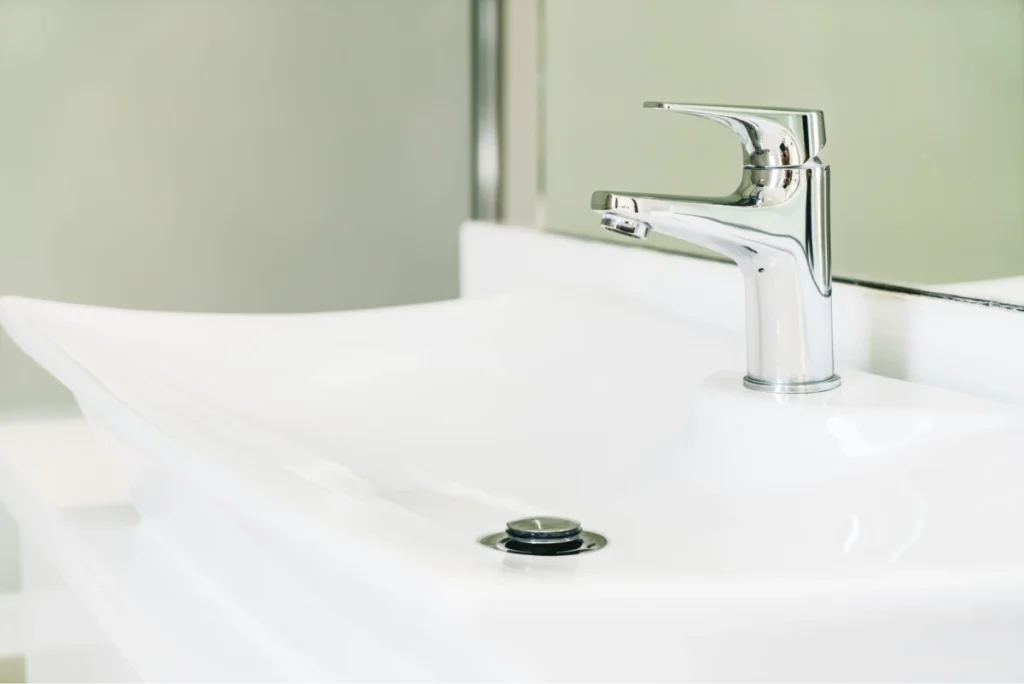
Widespread Faucets
Widespread faucets, also known as spread-fit faucets, are characterized by their three separate components: two handles and a spout. Unlike single-hole faucets, widespread faucets are installed through three separate mounting holes in the bathroom sink or countertop. This design offers a classic and elegant aesthetic, with the handles and spout spaced apart for a balanced and symmetrical look.
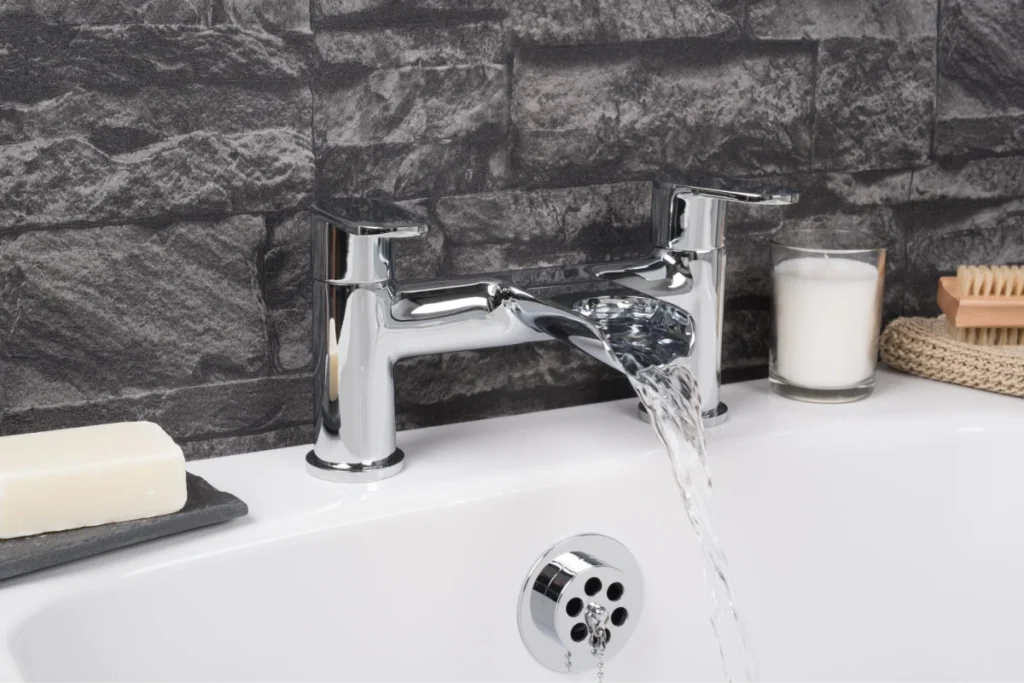
Factors to Consider When Choosing a Faucet
When selecting a faucet for your bathroom sink, it’s important to keep in mind a few crucial factors. This will ensure that your faucet meets all your functional requirements and matches your aesthetic preferences. Here are the main factors you should consider:
Sink Compatibility
Before choosing a faucet, it’s important to examine the layout of your sink to determine the number of accessible mounting holes. Different faucets require specific hole configurations such as widespread, three-hole, or single-hole. It’s crucial to ensure that the faucet you choose suits your sink to avoid any installation problems.
Style and Design
When selecting a faucet for your bathroom, it’s important to consider its style and design so that it harmonizes with the existing decor. Whether you prefer a modern, traditional, or transitional look, pay attention to details like the shape of the faucet, the design of its handle, and the height of its spout to achieve the desired aesthetic appeal.
Finish and Material
The finish and material of a faucet are crucial factors for both durability and aesthetics. You should choose a finish that matches other fixtures in your bathroom, such as chrome, brushed nickel, bronze, or brass. Furthermore, to ensure long-lasting performance and resistance to corrosion, it is advisable to select high-quality materials like solid brass or stainless steel.
Water Efficiency
Water conservation is becoming increasingly important, and one way to contribute is by selecting a faucet with water-saving features. Look for faucets that have low-flow aerators or meet the WaterSense certification standards, ensuring that they use water efficiently without sacrificing performance. Investing in a water-efficient faucet can help to reduce water consumption and lower utility bills in the long run.
Ease of Use and Maintenance
When choosing a faucet, it’s important to consider how easy it is to use and maintain. This is especially important if you have specific accessibility needs or preferences. Look for a faucet with ergonomic handles and smooth operation, making it effortless. Additionally, choose a model with easy-to-clean surfaces and minimal crevices to simplify maintenance and prevent the buildup of dirt and grime.
Budget
When buying a faucet, it’s important to set a budget and think about its long-term value. While expensive faucets may have advanced features and better finishes, there are also affordable options that offer dependable performance and durability. To find the right faucet, you should aim for a balance between quality and cost-effectiveness, ensuring that it meets your needs without going over your budget.
When looking for a faucet for your bathroom sink, there are several factors to consider. By taking these factors into account, you can choose a faucet that not only works smoothly but also complements the overall look of your bathroom. Whether you prioritize sink compatibility, style, water efficiency, or budget, there is a perfect faucet out there to meet your needs.
Installation and Maintenance
Proper installation and maintenance of your faucet are vital for optimal performance. This guide will help you install and maintain your faucet correctly.

Tools and Materials
Before you begin the installation process, gather the necessary tools and materials to ensure a smooth and efficient installation. Common tools and materials required may include:
- Adjustable wrench or basin wrench
- Screwdriver (flathead or Phillips)
- Plumber’s tape (Teflon tape)
- Silicone sealant or plumber’s putty (if required)
- Towels or rags for cleanup
- A Bucket or container to catch water during installation
Make sure you have the proper tools and materials that match your faucet type and installation needs to avoid any complications during the installation process.
Installation Process
- Preparation: Turn off the water supply to the faucet by shutting off the corresponding shut-off valves located beneath the sink. Open the faucet to release any remaining water pressure and drain the lines.
- Remove Old Faucet (if applicable): Disconnect the supply lines and remove the old faucet by loosening the mounting nuts or bolts and securing it to the sink or countertop. Clean the area thoroughly to prepare for the new faucet installation.
- Install New Faucet: Follow the manufacturer’s instructions for installing the new faucet. This typically involves placing the faucet through the mounting hole(s) in the sink or countertop and securing it in place using mounting nuts or bolts. Connect the supply lines to the corresponding valves and tighten them securely.
- Sealing and Finishing: Apply the plumber’s tape (Teflon tape) to the threads of the supply line connections to ensure a tight seal. Use silicone sealant or plumber’s putty around the base of the faucet if required, following the manufacturer’s recommendations.
- Testing: Turn on the water supply and test the faucet for leaks or drips. Check for proper water flow and temperature control by operating the faucet handle(s) or lever(s). Make any necessary adjustments to ensure the faucet is functioning correctly.

Maintenance Tips
- Regular Cleaning: Keep your faucet clean by wiping it down regularly with a mild soap solution and a soft cloth. Avoid abrasive cleaners or scrubbing pads that could scratch the faucet’s finish.
- Check for Leaks: Periodically inspect the faucet and supply lines for any signs of leaks or drips. Address any leaks promptly to prevent water damage and maintain optimal performance.
- Clean Aerator: Remove and clean the aerator on the faucet spout periodically to remove any debris or mineral buildup that could affect water flow. Soak the aerator in vinegar or a descaling solution to dissolve stubborn deposits.
- Lubricate Moving Parts: Apply a small amount of silicone-based lubricant to the faucet handle(s) or lever(s) and any moving parts to ensure smooth operation and prevent stiffness or sticking.
If you want your faucet to function perfectly and retain its durability and appearance for a long time, it’s important to follow the installation and maintenance guidelines. Proper installation and regular maintenance play a crucial role in enhancing the performance and lifespan of your faucet, ensuring that your investment is worth it.
Conclusion
Picking the right faucet for your bathroom sink is a crucial decision that involves both functionality and style. In this guide, we have discussed various factors that you need to consider, including sink compatibility and maintenance requirements, to ensure that your faucet meets your practical needs and enhances the overall look of your bathroom. By taking these factors into account, you can confidently choose a faucet that blends well with your daily routine and adds an exquisite touch to your home.
There are many types of faucets available, including compression, cartridge, ball, ceramic disc, wall mount, single hole, and widespread faucets. By understanding the unique features and benefits of each faucet type, you can choose the one that suits your bathroom design preferences and practical requirements.
Invest in a high-quality faucet for your bathroom sink that meets your needs. Consider durability, water efficiency, maintenance, and budget to select the perfect faucet. This guide provides useful insights and guidance.
Related Questions
How do I know if a faucet will fit my sink?
When selecting a faucet for your sink, it’s important to consider the number of mounting holes in your sink and their spacing. Most faucets are made to fit sinks with one, three, or four mounting holes. Make sure to measure the distance between the holes to ensure they match the faucet’s spout and handle configuration. Also, take into account the depth and shape of your sink basin to ensure that the faucet’s spout and handles can easily reach and function within the basin without any obstruction. If you’re unsure, it’s recommended to check the faucet manufacturer’s specifications or consult with a professional to ensure compatibility.
Do all bathroom faucets fit all sinks?
It’s important to note that not all bathroom faucets are compatible with all sinks. To ensure a proper fit and functionality, it’s crucial to consider the number of mounting holes in the sink, the spacing between them, and the design and configuration of the faucet. Faucets come in various types, including single-hole, three-hole, and widespread configurations, each requiring a corresponding number and arrangement of mounting holes in the sink. Additionally, the size, shape, and depth of the sink basin can also impact compatibility. To avoid any confusion, it’s best to refer to the manufacturer’s guidelines or seek assistance from a professional.
How far should the faucet extend into the bathroom sink?
The appropriate extension of a faucet into a bathroom sink is determined by various factors, such as the sink basin’s size, shape, and the faucet’s design and spout length. In general, the faucet should extend far enough into the sink to enable comfortable use, without causing splashing or water runoff onto the countertop. The spout should ideally extend far enough over the sink basin to reach its center, ensuring sufficient coverage and accessibility for handwashing and other tasks. However, it’s crucial to consider the specific dimensions and configuration of both the sink and the faucet to determine the appropriate extension for optimal functionality and aesthetics.
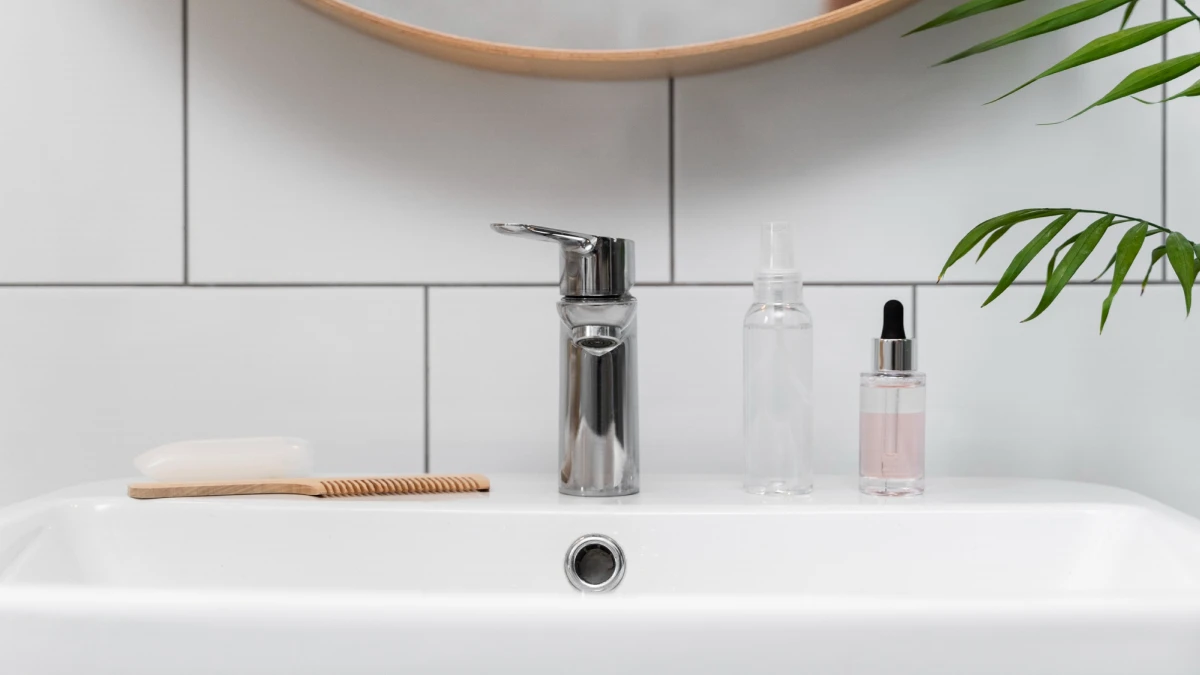
Leave a Reply